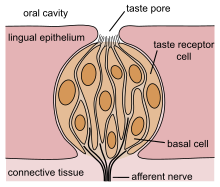**1. Basic Tastes:**
– Taste buds detect saltiness, sweetness, bitterness, sourness, and savoriness.
– Umami, known as savory, was postulated in Japanese research.
– Salt and sour tastes detect sodium chloride and acids in different ways.
– Salt plays a critical role in ion and water homeostasis in mammals.
– Sweet taste signals the presence of carbohydrates, high in calorie content.
– Pungency and hotness have been considered a sixth basic taste.
**2. Taste Perception:**
– Taste receptors interact with molecules to distinguish flavors.
– Taste contributes partially to food sensation; other factors include smell and texture.
– Basic tastes bring caution or craving based on their effects on the body.
– Taste perception diminishes with age, leading to taste distortions.
– Not all mammals share the same taste receptors as humans.
**3. Taste Detection:**
– Taste buds are located on the tongue, roof, sides, back of the mouth, and throat.
– Each taste bud contains 50 to 100 taste receptor cells.
– Filiform papillae on the tongue do not contain taste buds.
– The gustatory cortex in the brain is responsible for taste perception.
– Taste receptors in the mouth sense the five basic tastes distinctly.
**4. Health and Taste:**
– Taste helps animals distinguish safe and harmful food.
– Digestive enzymes in saliva dissolve food into base chemicals for taste detection.
– Salt and sour tastes can be pleasant in small quantities.
– Sweet taste signals the presence of energy-rich foods.
– Taste perception fades with age, affecting taste buds and saliva production.
**5. Specific Taste Components:**
**Sweetness:**
– Sweetness is produced by sugars and sugar mimics containing a carbonyl group.
– Detected by G protein-coupled receptors (GPCR) linked to gustducin on taste buds.
– Activation of T1R2+3 and T1R3 receptors is required for sweetness perception.
– Detection thresholds are rated relative to sucrose.
– Average human threshold for sucrose is 10 millimoles per liter.
**Sourness:**
– Sour taste detects acidity.
– Sourness rated relative to dilute hydrochloric acid.
– Detected by Type III taste receptor cells.
– Sour substances rich in H+ ions directly enter cells through proton channels.
– Sour foods include lemon, lime, grape, orange, tamarind, and bitter melon.
**Saltiness:**
– Saltiness has low-salt and high-salt components.
– Low-salt signal caused by epithelial sodium channel (ENaC).
– Saltiness rated relative to sodium chloride (NaCl).
– Potassium chloride (KCl) has a saltiness index of 0.6.
– High-salt signal poorly understood, not blocked by amiloride.
**Bitterness:**
– Bitter taste indicates potential poison.
– Detected by various receptors and transduction pathways.
– Bitterness is perceived as unpleasant by many.
– Common bitter foods include coffee, cocoa, bitter gourd, and olives.
– Bitter compounds often toxic, leading to a strong evolutionary sensitivity.
**Umami:**
– Umami taste detects savory or meaty flavors.
– Detected by umami receptors sensitive to glutamate.
– Umami taste often associated with amino acids and nucleotides.
– Monosodium glutamate (MSG) commonly used to enhance umami taste.
– Foods rich in umami include tomatoes, mushrooms, soy sauce, and aged cheeses.
The gustatory system or sense of taste is the sensory system that is partially responsible for the perception of taste (flavor). Taste is the perception stimulated when a substance in the mouth reacts chemically with taste receptor cells located on taste buds in the oral cavity, mostly on the tongue. Taste, along with the sense of smell and trigeminal nerve stimulation (registering texture, pain, and temperature), determines flavors of food and other substances. Humans have taste receptors on taste buds and other areas, including the upper surface of the tongue and the epiglottis. The gustatory cortex is responsible for the perception of taste.

The tongue is covered with thousands of small bumps called papillae, which are visible to the naked eye. Within each papilla are hundreds of taste buds. The exceptions to this is the filiform papillae that do not contain taste buds. There are between 2000 and 5000 taste buds that are located on the back and front of the tongue. Others are located on the roof, sides and back of the mouth, and in the throat. Each taste bud contains 50 to 100 taste receptor cells.
Taste receptors in the mouth sense the five basic tastes: sweetness, sourness, saltiness, bitterness, and savoriness (also known as savory or umami). Scientific experiments have demonstrated that these five tastes exist and are distinct from one another. Taste buds are able to tell different tastes apart when they interact with different molecules or ions. Sweetness, savoriness, and bitter tastes are triggered by the binding of molecules to G protein-coupled receptors on the cell membranes of taste buds. Saltiness and sourness are perceived when alkali metals or hydrogen ions meet taste buds, respectively.
The basic tastes contribute only partially to the sensation and flavor of food in the mouth—other factors include smell, detected by the olfactory epithelium of the nose; texture, detected through a variety of mechanoreceptors, muscle nerves, etc.; temperature, detected by temperature receptors; and "coolness" (such as of menthol) and "hotness" (pungency), by chemesthesis.
As the gustatory system senses both harmful and beneficial things, all basic tastes bring either caution or craving depending upon the effect the things they sense have on the body. Sweetness helps to identify energy-rich foods, while bitterness warns people of poisons.
Among humans, taste perception begins to fade during aging, tongue papillae are lost, and saliva production slowly decreases. Humans can also have distortion of tastes (dysgeusia). Not all mammals share the same tastes: some rodents can taste starch (which humans cannot), cats cannot taste sweetness, and several other carnivores, including hyenas, dolphins, and sea lions, have lost the ability to sense up to four of their ancestral five basic tastes.
English
Alternative forms
- tast (obsolete)
Etymology 1
From Middle English tasten, borrowed from Old French taster, from assumed Vulgar Latin *tastāre, from assumed Vulgar Latin *taxitāre, a new iterative of Latin taxāre (“to touch sharply”), from tangere (“to touch”), ultimately from Proto-Indo-European *teh₂g-.





